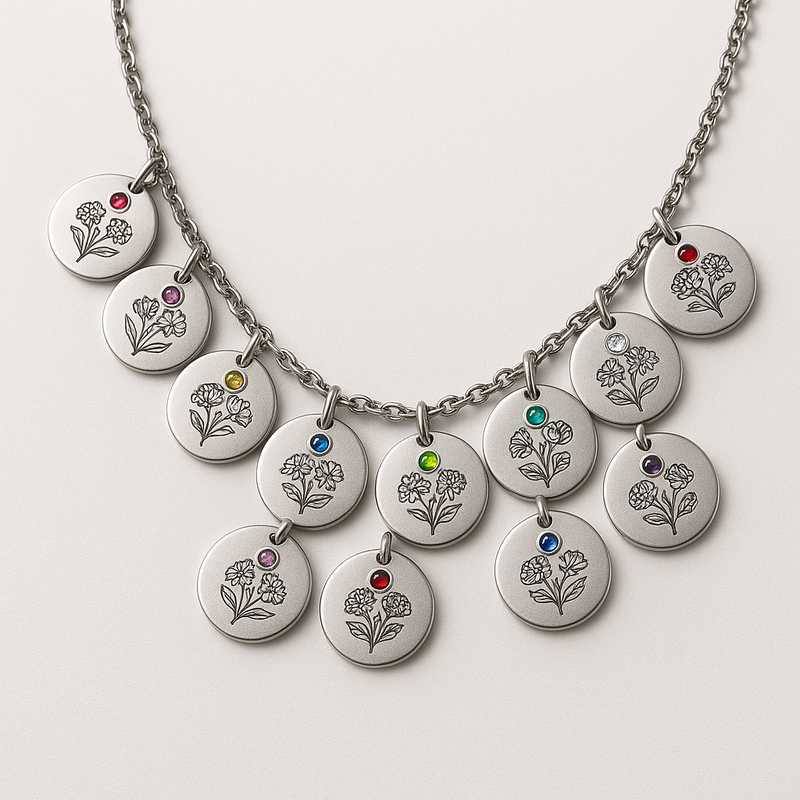Precision Crafting of Birthstone Charm Necklaces: Stainless Steel Innovations

Explore the power of 304 vs. 316L stainless steel, cutting-edge manufacturing, and eco-friendly technologies driving the future of custom jewelry.
In the rapidly evolving world of stainless steel jewelry manufacturing, precision and sustainability are more than industry buzzwords—they are competitive necessities. As demand for bespoke, durable, and eco-conscious products continues to rise, B2B clients are seeking partners who not only understand the complexities of stainless steel but also push the boundaries of what’s possible in jewelry design and fabrication.
Our deep dive into the crafting of birth month flower birthstone charm necklaces reveals the advanced materials and technologies redefining this niche. From the nuanced applications of 304 and 316L stainless steel to the integration of cutting-edge laser cutting and hydraulic processes, this guide explores how innovation meets customization. Discover how these practices elevate product quality, reduce waste, and unlock scalable OEM/ODM potential for global partners.
Understanding Stainless Steel Grades: 304 vs. 316L in Jewelry Applications
At the core of premium charm necklace production lies the choice of stainless steel. The industry standard—grades 304 and 316L—offer distinct advantages, but their suitability depends heavily on the intended application, target market, and aesthetic goals.
304 Stainless Steel: Strength and Affordability
Grade 304 stainless steel, an alloy composed primarily of iron, chromium (18%), and nickel (8%), is prized for its mechanical strength and corrosion resistance under general atmospheric conditions. Its affordability makes it an excellent choice for fashion jewelry and collections intended for urban, non-marine environments.
- High tensile strength ideal for intricate charm frames
- Good weldability, enabling seamless assembly
- Economical solution for mass-market customization
316L Stainless Steel: The Anti-Corrosion Champion
Grade 316L, a low-carbon version of 316 steel, contains added molybdenum (2-3%) which significantly enhances its resistance to chloride corrosion and pitting. It is the go-to material for luxury and hypoallergenic jewelry lines.
- Excellent performance in coastal and humid regions
- Ideal for medical-grade or skin-contact applications
- Perfect for engraved, long-lasting personalized charms
Choosing between these two depends on whether cost efficiency or performance under demanding conditions is the priority. Both materials support high-quality finishes, but only 316L offers the resilience needed for heirloom-grade jewelry.
From Blueprint to Brilliance: Advanced Manufacturing Techniques
Custom charm necklaces require a blend of traditional craftsmanship and state-of-the-art technology. Modern manufacturing processes like laser cutting, hydraulic forming, and corrosion patterning provide unmatched precision while enabling scalability.
Laser Cutting for Unparalleled Detailing
Laser cutting enables intricate patterning of birth month flowers and gemstone settings with micron-level accuracy. This technology ensures consistency across batches, a must for OEM and ODM clients seeking to uphold brand standards.
- Supports delicate floral outlines with minimal burring
- Faster prototyping for customized charm layouts
- Enables mixed-material integration with surgical accuracy
Hydraulic Forming for Structural Integrity
Hydraulic presses shape stainless steel without compromising its internal structure. This process is ideal for forming convex charm bases, smooth bezels for birthstones, and clasp components that must endure repeated handling.
- Reduces microfractures and deformation during shaping
- Enables production of three-dimensional charm profiles
- Consistent output for high-volume B2B projects
Corrosion Patterning: Aesthetic Meets Engineering
Advanced etching and corrosion patterning techniques introduce unique surface designs by selectively removing chromium layers. These can highlight the symbolic flower designs for each birth month, offering tactile contrast and artistic appeal.
- Enables subtle contrast between polished and matte zones
- Enhances visual depth without compromising integrity
- Ideal for branding, limited editions, and artist collaborations
Green Manufacturing: Eco-Friendly Innovation in Jewelry Production
Environmental stewardship is not just good ethics—it’s good business. As B2B buyers seek sustainable suppliers, manufacturers are turning to cleaner processes that reduce waste and environmental footprint while maintaining superior product quality.
Closed-Loop Waste Management
Modern jewelry workshops implement closed-loop water and metal recovery systems to reuse polishing residues, cutting fluids, and dust particles. This not only minimizes landfill output but also reduces material costs in the long run.
- Reclaims up to 90% of cutting and polishing waste
- Lowers environmental compliance costs
- Improves operational transparency for ESG reporting
Green Electroplating: Less Toxic, More Brilliance
Electroplating, essential for finish variety (e.g., gold, rose gold, black), is undergoing a green transformation. Replacing cyanide and hexavalent chromium with organic and non-toxic compounds reduces environmental risks and improves worker safety.
- Improves plating bath longevity and uniformity
- Enables compliance with RoHS and REACH regulations
- Supports branding through ethical sourcing claims
Energy-Efficient Production Systems
LED-based curing ovens, solar-powered workshops, and digitally optimized CNC systems allow manufacturers to significantly reduce their carbon emissions. Energy audits and AI-powered demand forecasting further enhance resource management.
These eco-initiatives attract B2B clients who prioritize carbon-conscious supply chains and seek suppliers aligned with green certifications and sustainability indices.
Case Study Spotlight: Scalable Customization for Global Retailer
One of our flagship projects involved developing a seasonal birthstone charm necklace line for a North American retailer with over 800 locations. The client required monthly variations, regional metal preferences, and minimal environmental impact.
Challenge:
Create 12 charm variants using 316L stainless steel with engraved birth month flowers and gemstone slots, adhering to strict eco-compliance policies.
Solution:
- Laser engraving ensured uniform floral detailing
- Recycled 316L stainless steel used for all bases
- Green electroplating achieved desired finishes without heavy metals
Outcome:
- Delivered 50,000 units within 60 days
- Product line received sustainability certification from third-party auditor
- Client reported 35% increase in seasonal jewelry sales
Conclusion: Partnering for Precision and Progress
As the demand for personalized and sustainable jewelry continues to climb, stainless steel charm necklaces offer a compelling fusion of durability, beauty, and environmental responsibility. By understanding the nuanced applications of 304 and 316L stainless steel, leveraging precision technologies, and embracing green production practices, manufacturers can deliver exceptional value to B2B partners worldwide.
Looking for a manufacturing partner that blends innovation with integrity? Contact us today to explore OEM/ODM opportunities tailored to your brand’s vision and sustainability goals.
